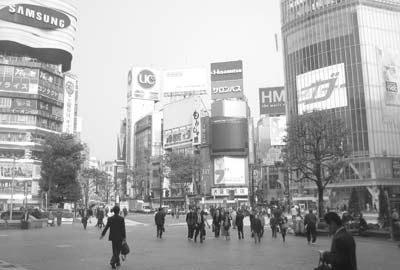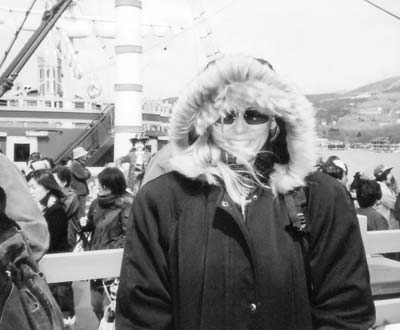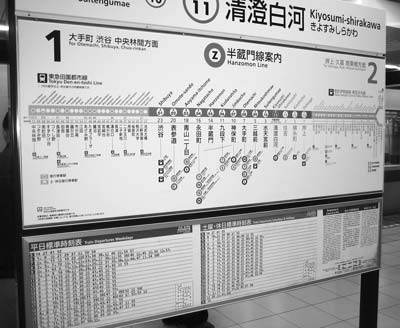Japan — Traveling solo in Tokyo
Susan Benton, Hermosa Beach, CA

Recently, I had the opportunity to visit a friend’s parents who live in Tokyo. While I had a free place to stay, I had no tour guide, no mode of transportation and no sense at all of Tokyo and its culture beyond what I had gleaned from guidebooks and depictions in movies à la “Lost in Translation.”
My hosts were gracious and accommodating, providing useful information that went beyond my guidebook and steering me in the right direction on things to do and see. On a few occasions we dined together in the evenings. However, both teachers at the American School in Japan, they had to work midweek, so I was on my own to discover the city and outlying areas.
A bit of a challenge
Based on the maps I’d reviewed on the 11-hour flight from Los Angeles, I felt well versed on many areas of the city and comfortable choosing a path for my week-long trip.
Once there, I realized that — despite my preparation — navigating the transportation system, communicating with locals and understanding the layout of Tokyo was challenging — particularly since my guidebook, “Time Out Tokyo,” had lots of useful tidbits on the culture but left much to be desired in terms of practical details, especially when tackling Tokyo as a single woman.
When traveling alone, there are certain “must haves” that are necessary for navigating the city. Below is a checklist of the things every guidebook should note (and all the things I wish I would have known beforehand) for a successful, stress-free jaunt to Japan.
Directions
In addition to a comprehensive, detailed map of Tokyo, which you should carry with you at all times, make sure you have. . .
• A map of all the train lines and their schedules
You’ll need maps of the subway system, including one of the Yamanote loop and, perhaps most important, a map of the Yamanote Line connections throughout the city — more or less the backbone of the Tokyo train system and my primary mode of transportation while there.
• Detailed directions for day trips.
For supplemental trips outside of Tokyo, make sure you have a detailed map of the streets and transportation lines (if any) for each area once you arrive. Some areas, like Kamakura and Tokeiji near Sagami Bay, are remote; therefore, fewer details exist for the outskirts of these areas, and the likelihood that English will not be spoken is higher.

Note: it’s important to have the corresponding Japanese characters to accompany descriptions, especially for some of the more obscure areas. (As you get farther outside of Tokyo, the signs all switch from Romaji to Japanese characters.)
Shopping
For funky, fun shops, restaurants and people-watching, head to Harajuku. You’ll have the experience of seeing the impeccably made-up Harajuku kids and the overzealous street performers. You’ll also have a chance to catch up on the latest Japanese fashion trends by strolling shop to shop.
If cell phones are what you crave, head to Shibuya, where electronics stores line the crowded streets and compete for attention with loud ringtones and digital advances light-years ahead of those in the U.S.
Exploring less-touristy areas
While many guidebooks highlight Roppongi as the place to be in Tokyo, another area of the city, Kichijoji, often goes overlooked. Kichijoji has an energy all its own, boasting delicious restaurants, coffee shops, authentic karaoke bars and even ice cream parlors (open late).
Getting there — Kichijoji station is on the Keio Inokashira line (17 minutes from Shibuya by express train) and can also be reached via the JR Chuo or Sobu line (10 minutes from Shinjuku by express).
Nighttime is the right time
Japan historically has had a low crime rate, but this shouldn’t give you a false sense of security, especially when traveling alone.

As a general rule, women should be especially careful, particularly if out after the sun goes down. This happened to me a couple of times — either I caught the wrong train going the wrong direction or I simply lost track of time or miscalculated how long it would take to get home. Keep your wits about you. Chances are you’ll run into another traveler or a helpful local who can assist. The train stations all have helpful employees and information booths, as well.
Tip — when stepping off a train, remember to walk to the left. The Japanese drive on the left-hand side of the road, as well.
Get out of town
Narita International Airport is about 45 miles away from central Tokyo. As a rule of thumb, plan to buy N’EX (Narita Express) high-speed train tickets a day in advance for the train that will get you to the airport a half hour to one hour earlier than you would like to arrive. Delays are common — something I experienced firsthand. Luckily, I had purchased a ticket at a train station in Tokyo to arrive one hour earlier than I needed to be at the airport; I arrived just in time for my flight home. Tickets can also be purchased at major stations on the JR Line; look for separate ticketing areas called Midori-no-Madoguchi (Green Ticket Windows) for long-distance tickets or seat reservations.

Money matters
The best advice for obtaining yen? Save yourself the hassle and exchange your money before you leave. Getting money once you’re there can be difficult.
The CitiBank across the street from Shinjuku Station, as well as other select ATMs throughout Tokyo, take American bank cards, but that’s it.
Note that some temples and shrines charge high entry rates, while other equally impressive temples cost next to nothing or are free. Choose wisely based on your budget.
Japanese etiquette
When visiting a temple with services in progress, are you being disrespectful if you join, watch or speak? Visitors are generally accepted if they wish to pray, but they are expected to show respect at temples and shrines. This includes offering donations and washing one’s hands in the fountains before entering.
Beyond temple etiquette, there is general social etiquette to keep in mind. One thing to note is that the Japanese consider eating on the trains rude, as I found out the hard way when my crunching into an apple was met with incredulous, disgusted stares from the few Japanese passengers sharing my particular train. Don’t do it.
Day-tripping
For an incredible sensory experience, visit Hakone. On a clear day, you’ll see breathtaking views of Mt. Fuji and will have the opportunity to experience some of the most unique geographic areas that all of Japan has to offer.

To see the Hakone region, take the Odakyu and Odawara trains out of Tokyo and hop on the Hakone-Yumoto Tozan line. Then catch the Hakone-Tozan Cablecar, the funicular railway that climbs the mountainside, before boarding the Hakone Ropeway (Japan’s longest cable car route) to the Owakudani. From there, a gondola will take you 200 feet above the sulfur pits and over the ridge. At the top, you can check out the hot springs or walk the short route, or continue on the cable car, down to Togendai, where you can catch the garish pirate-themed boat (you can’t miss it) to cross Lake Ashi.
Lake Ashi, located in the crater of Hakone Volcano, was formed following a phreatic explosion 3,000 years ago. It never freezes due to the volcanic activity still going on beneath, which also accounts for Owakudani’s sulfur production.
Once you’ve crossed to Hakonemachi, you’ll be rewarded with a gorgeous shot of the lake with Mt. Fuji presiding powerfully in the distance. Stop at the gift shop in Hakonemachi for a quick bite of soba noodles and, for dessert, sample candy and custard made of every type of Japanese “bean jelly” imaginable.
Whatever your preference in travel, Tokyo and its surrounding areas are meant to be explored. With the right travel tools and a dedicated amount of time, your trip will be a memorable one.
